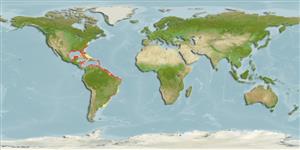Environment: milieu / climate zone / depth range / distribution range
Ecologie
marien; brak water demersaal; diepte ? - 55 m (Ref. 26912). Tropical; 20°C - 25°C (Ref. 36323)
Western Atlantic: southern Caribbean to Brazil. Record from the Virgin Islands needs verification.
Grootte / Gewicht / Leeftijd
Maturity: Lm ? range ? - ? cm
Max length : 26.0 cm TL mannelijk / geslacht onbekend; (Ref. 5217); common length : 20.0 cm TL mannelijk / geslacht onbekend; (Ref. 5217); max. gepubliceerd gewicht: 101.40 g (Ref. 118626)
Dorsale stekels (totaal) : 10; Dorsale zachte stralen (totaal) : 12 - 14; Anale stekels: 3; Anale zachte stralen: 7. Body dusky green with 2 longitudinal dark stripes; cheeks yellowish olive with diagonal blue stripes; fins dusky; anal and caudal fins with a tinge of yellow (Ref. 13608). Preopercle with a single prominent group of spines at the angle; 3 flat spines on posterior part of opercle. Soft portions of dorsal and anal fin bases without scales. Pectoral fin longer than pelvic fin. Caudal fin with no elongated ray (Ref. 36323).
Occurs commonly in coastal waters and also enter estuarine regions (Ref. 36323). Found over soft bottoms. Flesh is of good quality and is eaten fresh.
Indeterminate fecundity with asynchronous ovarian organization (Ref. 115898).
Cervigón, F., R. Cipriani, W. Fischer, L. Garibaldi, M. Hendrickx, A.J. Lemus, R. Márquez, J.M. Poutiers, G. Robaina and B. Rodriguez, 1992. Fichas FAO de identificación de especies para los fines de la pesca. Guía de campo de las especies comerciales marinas y de aquas salobres de la costa septentrional de Sur América. FAO, Rome. 513 p. Preparado con el financiamento de la Comisión de Comunidades Europeas y de NORAD. (Ref. 5217)
Status op de Rode Lijst van het IUCN (Ref. 130435)
Gevaar voor de mens
Harmless
Gebruik door de mens
Visserij: van minder commercieel belang
Tools
Speciale rapporten
Download XML
Internetbronnen
Estimates based on models
Preferred temperature (Ref.
123201): 22.7 - 27.9, mean 25.6 °C (based on 430 cells).
Fylogenetische diversiteitsindex (Ref.
82804): PD
50 = 0.5002 [Uniqueness, from 0.5 = low to 2.0 = high].
Bayesian length-weight: a=0.00631 (0.00449 - 0.00888), b=3.14 (3.04 - 3.24), in cm total length, based on LWR estimates for this species (Ref.
93245).
Trofisch niveau (Ref.
69278): 4.1 ±0.68 se; based on food items.
Weerstandsvermogen (Ref.
120179): Gemiddeld, minimale populatieverdubbelingstijd 1,4-4,4 jaar (Preliminary K or Fecundity.).
Fishing Vulnerability (Ref.
59153): Low vulnerability (16 of 100).
Nutrients (Ref.
124155): Calcium = 183 [78, 350] mg/100g; Iron = 0.97 [0.53, 1.79] mg/100g; Protein = 17.6 [15.8, 19.3] %; Omega3 = 0.188 [0.099, 0.368] g/100g; Selenium = 46.9 [23.7, 93.7] μg/100g; VitaminA = 30.5 [11.6, 96.1] μg/100g; Zinc = 1.39 [0.96, 1.98] mg/100g (wet weight);
